 Most viewed - HYOGO 兵庫県 Most viewed - HYOGO 兵庫県 |

Eirakukan's rotating kabuki stage.52 views
|
|

Bottom of Kobe Port Tower.51 views
|
|

Phone booth at Nankinmachi, Kobe's Chinatown.51 views
|
|

You can also go underneath the stage and see the revolving stage. It's rotated by hand. Wow neat, how often can you see something like this?51 views
|
|

The bus going to Hyogo Park of the Oriental White Stork Park is designed like a bag to promote Toyooka as a bag-producing city.51 views
|
|

Shinkoro Clock Tower was orignally used to beat taiko drums from 7 am to 9 am to notify people that the castle lord arrived at the castle. A mechanical clock from the Netherlands was later donated by a local doctor to make it a clock tower in 1881. 辰鼓50 views
|
|

Hyogo Park of the Oriental White Stork has a few buildings amid large rice paddies and mountains.50 views
|
|

The Oriental white stork has black and white wings and a black bill.50 views
|
|

The storks are carnivores, feeding on fish, frogs, snakes, rabbits, mice, etc. 50 views
|
|

As of Oct. 2018, Japan has over 140 Oriental white storks in the wild. They are also successfully breeding in Tokushima, Shimane, and Kyoto Prefectures. 50 viewsIt's still an endangered species, with only slightly over 2,000 of them in the Far East.
|
|
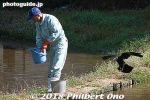
Crows also drop by.50 views
|
|

Park's website: http://www.stork.u-hyogo.ac.jp/en/50 views
|
|

Toyooka in Hyogo Prefecture is a major producer of bags. Thier local bus even has a bag design.49 views
|
|

Toyooka's bag bus.49 views
|
|

Eirakukan (永楽館), the Kansai Region's oldest kabuki theater built in 1901. Toward the left was the theater's front entrance that is not used anymore because of the road right in front. They now use a side entrance.49 views
|
|

Toyooka Oriental White Stork Culture Center's open cage for Oriental white storks. It includes paddies used for feeding. The cage is "open" because it only hasa fence and no roof.49 views
|
|

Toyooka Oriental White Stork Culture Center's open cage for Oriental white storks. There are about nine storks in the open cage. Their wings have been clipped to they cannot fly. 49 views
|
|

About the Oriental white stork open cage.49 views
|
|

They are throwing small dead fish into the paddies. 49 views
|
|
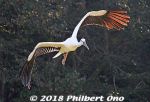
49 views
|
|

49 views
|
|
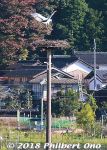
Landing on a nesting platform.49 views
|
|

The hanafuda card with the "crane" is actually an Oriental white stork. It actually looks like a cross between the two birds...49 views
|
|

49 views
|
|

49 views
|
|

Gift shops in this building next to the parking lot.49 views
|
|

Eirakukan Theater in Izushi, Toyooka, Hyogo.48 views
|
|

Oriental white stork decoration at JR Toyooka Station. To see real, living Oriental white storks, you have to visit the Hyogo Park of the Oriental White Stork Park.48 views
|
|

48 views
|
|

Huge rice paddy within Hyogo Park of the Oriental White Stork.48 views
|
|

Inside the Oriental White Stork Culture Center. Walk through this building to the other side of the building to see the open cage.48 views
|
|

So if you go to Hyogo Park of the Oriental White Stork, you can see real Oriental white storks.48 views
|
|

In 1985, six wild Oriental white stork chicks from the USSR (Khabarovsk) were acquired to be raised in Toyooka. From 1989, the birds from Russia started to breed successfully in captivity in Toyooka every year. 48 views
|
|

48 views
|
|

48 views
|
|

48 views
|
|

They make a loud clacking noise with their bills.48 views
|
|

48 views
|
|

Storks swallow the fish whole.48 views
|
|

Exhibits.48 views
|
|

Even insects.48 views
|
|

Confection shaped like stork eggs.48 views
|
|

Rice paddy has a high nesting platform. The nest still intact.47 views
|
|

The building in the middle is the University of Hyogo Graduate School of Regional Resource Management.47 views
|
|

Once found all over Japan, the Oriental white stork ("kounotori" in Japanese) became extinct in the wild in Japan in 1971 despite preservation efforts since 1955.47 views
|
|

From 2005, the park started releasing Oriental white storks into the wild in Toyooka, which was a great celebration. The birds then started to breed and reproduce in the wild.47 viewsThey've been releasing only a few birds (fewer than 5) almost every year.
|
|

47 views
|
|

Oriental white stork nests are large, about 2 meters diameter, made of tree branches and straw.47 views
|
|

47 views
|
|

Nesting platform.47 views
|
|

About the biotope.47 views
|
|

From JR Toyooka Station, there are buses that go to Hyogo Park of the Oriental White Stork Park. However, they run only once or twice an hour. Bus schedule under the purple column.46 views
|
|

Kounotori can also mean "bird bringing happiness." Sculpture related to the bird of happiness. Makes people happy especially when the stork delivers your baby.46 views
|
|

Gate to Hyogo Park of the Oriental White Stork. Open: 9:00 am–5:00 pm, closed Mondays (open if a national holiday and closed the next day instead), December 28th–January 4th.46 views
|
|

Basic map of Hyogo Park of the Oriental White Stork. Only one building on the left is open to the public.46 views
|
|

Around 9:30 am to 10 am, they feed the storks. This is the best time to visit the park. And the best chances of seeing storks flying around.46 views
|
|
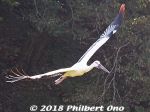
46 views
|
|

Back inside the Oriental White Stork Culture Center. On the left is the European white stork with a red bill, on the right is the Oriental white stork with a black bill. Very similar.46 views
|
|

46 views
|
|

46 views
|
|

46 views
|
|

On the right is the park's administrative building.45 views
|
|

On the left is the Toyooka Kounotori Bunkakan or Oriental White Stork Culture Center.45 views
|
|
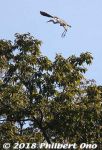
45 views
|
|

45 views
|
|

45 views
|
|

Screening room.45 views
|
|

Aquariums with fish.45 views
|
|

Part of the park is a large biotope used as a stork sanctuary and research facility. Only part of it is open to the public.45 views
|
|

Large biotope used as a stork sanctuary and research facility.44 views
|
|

Monument for the "Birthplace of Japan's Emigration to Brazil" (ブラジル移民発祥の地)42 views
|
|

Artist studio41 views
|
|

Meriken Park also has this impressive monument of Japanese emigrants to South America. Built in April 2001 by local Brazilian organizations.41 views
|
|

Dressing room.41 views
|
|

Kobe Center for Overseas Migration and Cultural Interaction was originally the National Emigration Center (国立移民収容所) where Japanese immigrants stayed for orientation before traveling mainly to South America (especially Brazil) by boat.40 viewsThe Emigration Center was used from 1928 to 1971 and it's Japan's only surviving building used for sending Japanese immigrants. Later renamed Kobe Emigrant Education Center and then Kobe Emigrant Assistance Center and Kobe Emigration Center (神戸移住センター).
|
|

Entrance.39 viewsOpen 10:00 am -5:00 pm (enter by 4:30 pm), closed Mon. (open if a national holiday and closed on Tue. instead) and December 29 to January 3. Admission: Free
|
|
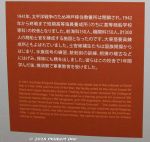
History of the emigrant center: 1940s39 views
|
|

Statue of emigrants to Brazil. This same statue also stands at Meriken Park in Kobe.39 views
|
|

Japanese language textbooks.39 views
|
|

Nice stairs39 views
|
|

Izushi's symbol is the Shinkoro Clock Tower. This area is also a National Important Traditional Townscape Preservation District (重要伝統的建造物群保存地区). 辰鼓楼39 views
|
|

Portuguese notices.38 views
|
|

Also a good snack is the Tajima beef bun.38 views
|
|

Warning sign for drivers for small children. (It means to go slow.)38 views
|
|

The 1st and 2nd floors have the emigration exhibition rooms. The 3rd floor is mainly offices of local Brazilian groups, and the 4th floor has rented studios for artists.37 views
|
|
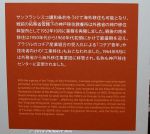
History of the emigrant center: 1950s-60s37 views
|
|
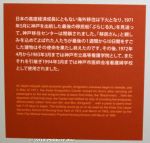
History of the emigrant center: 1970s-80s as a School of Nursing.37 views
|
|

Pictures of emigrants.37 views
|
|

Exhibition room37 views
|
|

This is how the sleeping quarters looked like at the Kobe emigration center.37 views
|
|

This is how the sleeping quarters looked like at the Kobe emigration center.37 views
|
|

Corridor on an upper floor.37 views
|
|

View of Meriken Park, Kobe's waterfront park that includes Kobe Maritime Museum, South American emigration monument, outdoor sculptures, and the preserved dock that was damaged by the Great Hanshin earthquake in 1995.37 views
|
|

View of Meriken Park from Kobe Port Tower.37 views
|
|

View of Meriken Park from Kobe Port Tower.37 views
|
|

Shinkoro Clock Tower in Izushi, Toyooka, Hyogo Prefecture is one of Japan's oldest clock towers along with the Sapporo Clock Tower also built in 1881. 辰鼓楼37 views
|
|

37 views
|
|

Izushi Town Hall37 views
|
|

Next to the station is this collection of donated geta wooden clogs from local inns.37 views
|
|

Drinkabke hot spring water in front of JR Kinosaki Onsen Station.37 views
|
|
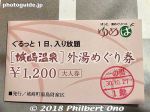
Guests who stay at a ryokan in Kinosaki Onsen can visit all seven public baths for free. But daytrippers like me have to pay admission for each one, costing ¥600 or ¥700. 37 viewsHowever, they have a public bath day pass for only ¥1,200 (外湯めぐり券). Use it to enter all seven. Great deal! Definitely one of the best bargains in Japan!
|
|

37 views
|
|

This was where the Japanese immigrants would stay for up to 10 days to prepare for their long boat journey and move to South America.36 viewsToday, the center is partially a museum where a few of the old rooms used by the emigrants have been restored. Other rooms are rented, including an event hall, meeting rooms, and gallery spaces. It includes a consultation center for South American residents of Kobe.
Museu da Emigração e Centro de Intercâmbio Cultural de Kobe
|
|

During World War II, the facility was used by the Japanese military. Then it became a school for hospital nurses. Today, the building is a South America emigration museum and the base for the Kansai Brazilian Community.36 viewsThere are exhibition rooms showing Kobe's history of Japanese immigration, especially to South America. Art studios, art gallery spaces, and meeting rooms are also provided for cultural exchange.
|
|

It is also has a consultation center for South American residents of Kobe. Operated by the city of Kobe, the current facility opened on June 3, 2009.36 views15-min. walk from JR Motomachi Station (East Exit) on the JR Tokaido/Kobe Line. Walk straight along Koikawa-suji road (鯉川筋). Or 10-min. walk from Kencho-mae Station on the subway line. From JR Shin-Kobe Station (shinkansen), 10-min. taxi ride.
|
|
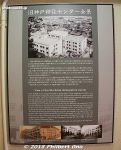
Old Kobe Immigration Center.36 views
|
|

Map of Kobe Port on the floor.36 views
|
|
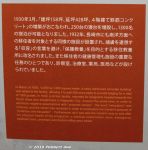
History of the emigrant center: 1930s36 views
|
|

This is how the sleeping quarters looked like at the Kobe emigration center.36 views
|
|

Emigrants' luggage.36 views
|
|

3rd floor36 views
|
|

Kobe Port Tower ticket window. 36 views
|
|

Meriken Park36 views
|
|

Roof above Cassa Armonica.36 views
|
|

Kobe Luminarie's Cassa Armonica (カッサ・アルモニカ). People lined up for the Cassa Armonica like a shrine.36 views
|
|

On Nov. 3, Izushi holds the Oshiro Matsuri to reenact the daimyo procession.36 views
|
|

Gokurakuji Temple's Sanmon Gate. 山門36 views
|
|

Kinosaki Onsen's hot spring source. 源泉36 views
|
|

Aboit Tajima beef and Kobe beef.36 views
|
|

Kinosaki Onsen Ropeway station.36 views
|
|

Onsenji Temple's Tahoto pagoda. 多宝塔36 views
|
|

Kinosaki Art Museum near Onsenji. Mostly Buddhist art. Small admission charged. Open 9 am–4:30 pm, closed second and fourth Thu. of the month when the ropeway is not operating. 城崎美術館36 views
|
|

Kou-no-Yu is open 7:00 am–11:00 pm, closed on Tue. Oriental white stork statues next to Kou-no-Yu.36 views
|
|

Emigrant ship to South America.35 views
|
|

It took over 50 days to travel from Japan to South America.35 views
|
|

History of the emigrant center.35 views
|
|
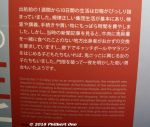
Life in the emigration center.35 views
|
|

Sports equipment.35 views
|
|

Vintage camera35 views
|
|

35 views
|
|

Back of the lights.35 views
|
|

Advertising posters on the walls.35 views
|
|

Backstage has the dressing rooms for actors. Normally hidden by a curtain.35 views
|
|

Shinkoro Clock Tower was first built in 1871 without any clock. 辰鼓楼35 views
|
|

About the Shinkoro Clock Tower. 辰鼓楼35 views
|
|

Inside JR Kinosaki Onsen Station.35 views
|
|

Jizo statue at Jizo-yu public bath.35 views
|
|

Willow trees along the river at Kinosaki Onsen hot spring. 柳の木35 views
|
|

Foot bath next to Ichinoyu public bath. 海内第一泉35 views
|
|

View from the cavern bath.35 views
|
|

Hiking path to Onsenji Temple, but taking the ropeway is easier and faster.35 views
|
|

Kinosaki Onsen Ropeway takes only 7 min. to the mountain summit. The ropeway runs three times an hour most of the day from 9:10 am to 5:10 pm.35 views
|
|

View of Kinosaki Onsen from the lookout deck.35 views
|
|

Crab monument. For all the crabs that are caught and eaten every year in northern Hyogo. かに塚35 views
|
|

Onsenji Temple's Hondo main hall.35 views
|
|

About Onsenji Temple.35 views
|
|

Onsenji Temple's bell dates back to the early Edo Period.35 views
|
|

At the bottom station of the ropeway is a small museum dedicated to Otagaki Shiro (1894–1964) who proposed the Kinosaki Onsen Ropeway that opened in May 1963. He was a native of Kinosaki and the first president of Kansai Electric Power Company.35 views太田垣士郎翁資料館
|
|

Entrance lobby of Kou-no-Yu. Shoe lockers on the left, and entrance to the women's bath on the right. 鴻の湯35 views
|
|

Farm tools34 views
|
|
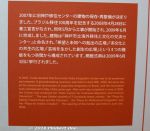
History of the emigrant center: 2007-200934 views
|
|
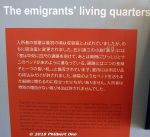
Emigrant's living quarters.34 views
|
|

Lodging facility reconstructed here.34 views
|
|

Electronical appliances.34 views
|
|

Exhibition room showing emigration photos.34 views
|
|

34 views
|
|

The tower's top five floors are lookout decks accessible by elevator.34 views
|
|

34 views
|
|

Entrance to Kobe Port Tower.34 views
|
|

Kobe Mosiac34 views
|
|

34 views
|
|

Restaurant inside Kobe Port Tower.34 views
|
|

Kobe Luminarie's Cassa Armonica (カッサ・アルモニカ). People gave donations.34 views
|
|

Stage curtains.34 views
|
|

34 views
|
|

34 views
|
|

Tojobashi Bridge to Izushi Castle's Tojomon Gate. 出石城 登城門・登城橋34 views
|
|

34 views
|
|

Ariko-yama Inari Jinja Shrine atop Izushi Castle's main foundation. 有子山稲荷神社 34 views
|
|

Toyooka also has Kinosaki Onsen (城崎温泉), a hot spring only 10 min. away by train from Toyooka Station. It's one of the best onsen I've ever visited in Japan.34 views
|
|

Free foot bath at Sato-no-Yu Onsen さとの湯. Great to relax your feet before getting on the train.34 views
|
|

People are encouraged to stroll around Kinosaki Onsen while wearing yukata. You can see more of them in the evening.34 views
|
|

The building is right next to a rock wall.34 views
|
|

Walking further along the mian drag.34 views
|
|

Jizo and Kannon statues along a rock wall.34 views
|
|

Gift shop and plaza next to the Kinosaki Onsen's hot spring source. 温泉たまご場34 views
|
|

Hot spring foot bath in Kinosaki Onsen.34 views
|
|

Kinosaki Onsen Ropeway goes up to Mt. Daishi.34 views
|
|

Golden Jibodai Kannon built in Oct. 2007. 慈母観音像34 views
|
|

Onsenji Temple's prayer tablet with Kannon on it.34 views
|
|

Onsenji Temple's Tahoto pagoda. 多宝塔 34 views
|
|

First floor of Onsenji Temple's Tahoto pagoda.34 views
|
|

Onsenji Temple's Tahoto pagoda dates back to 1768. It houses a Buddha statue. 金剛界大日如来34 views
|
|

Onsenji Temple's Tahoto pagoda.34 views
|
|

34 views
|
|

Locker and dressing room for men. 鴻の湯34 views
|
|

Kou-no-Yu's outdoor bath in a garden-like setting. 鴻の湯34 views
|
|

34 views
|
|

Room showing farm tools.33 views
|
|

Travel routes from Japan to South America.33 views
|
|

Kobe Port Tower top lookout deck.33 views
|
|

Views from Kobe Port Tower.33 views
|
|

View of Meriken Park from Kobe Port Tower.33 views
|
|

Emigration monument at Meriken Park.33 views
|
|

33 views
|
|

Another lookout deck.33 views
|
|
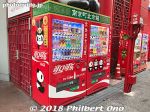
Vending machines in Chinese.33 views
|
|
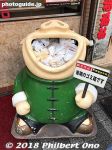
Trash talk33 views
|
|

You have to take off your shoes.33 views
|
|

33 views
|
|

Rotating kabuki stage.33 views
|
|

Bathtub for actors.33 views
|
|

Other stairway.33 views
|
|

Izushi Castle in Toyooka was built in the early 17th century. No original structures remain except for the stone walls and foundations. Reconstructed turrets and a small shrine are on the castle grounds. 出石城33 views
|
|

Izushi Castle's Honmaru has a large stone foundation for the main tower,33 views
|
|

There are over 30 torii gates to the shrine.33 views
|
|

Ariko-yama Inari Jinja Shrine atop Izushi Castle's main foundation. 有子山稲荷神社 33 views
|
|

Views of Izushi.33 views
|
|

Views of Izushi from Izushi Castle.33 views
|
|

Japanese pine tree.33 views
|
|

33 views
|
|

Going back down through the torii gates.33 views
|
|

33 views
|
|

Gift shop in Izushi.33 views
|
|

Gift shop in Izushi.33 views
|
|

Samurai residence.33 views
|
|

These five plates are not much for the average stomach. It was a good snack. 出石そば33 views
|
|

In front of JR Kinosaki Onsen Station.33 views
|
|

Next to JR Kinosaki Onsen Station is one of the seven celebrated public baths. This one is named Sato-no-Yu Onsen. Chinese-style building that includes a cold bath. Open 1:00 pm–9:00 pm, closed Mon. さとの湯33 views
|
|

33 views
|
|

The main drag of Kinosaki Onsen goes along the Otani River (Otanigawa) lined with pretty willow trees. 大谿川33 views
|
|

Entrance hall of Jizo-yu. Entrance for the men's bath on the left, and women on the right. Jizo-yu also has private baths. 地蔵湯33 viewsAll the public baths are segregated for men and women. A few of the public baths also have private baths that families or couples can rent.
|
|

Dressing and locker room for men at Jizo-yu.33 views
|
|

About Jizo-yu. 地蔵湯33 views
|
|

33 views
|
|

Willow trees along the river at Kinosaki Onsen hot spring. 33 views
|
|

The traditional building is Yanagi-yu. 柳湯33 views
|
|

The hot spring water came from the bottom of a willow tree for this public bath. Wooden interior.33 views
|
|

It says "Kinosaki Onsen well matches people in yukata."33 views
|
|

About Yanagi-yu public bath. 柳湯33 views
|
|

Foot bath next to Ichinoyu public bath. 海内第一泉33 views
|
|

Near Ichinoyu is this fountain for drinkable hot spring water.33 views
|
|

Gosho-no-yu (御所の湯).33 views
|
|

Rest area inside Gosho-no-yu (御所の湯).33 views
|
|

About the Benzaiten shrine.33 views
|
|

Near Mandarayu is Gokurakuji Temple, a Rinzai Zen Buddhist temple. It worships Amida Nyorai. 本堂33 views
|
|

Way to Onsenji Temple.33 views
|
|

Niomon Gate to Onsenji's Yakushido Hall. 仁王門33 views
|
|

You can soft-boil your onsen eggs yourself in hot spring water. Boil the eggs for 11 min.33 views
|
|

After 11 min., the eggs were perfectly soft boiled. A niftly tool cut away the top portion of the egg shell. Sprinkle some salt and yummy!33 views
|
|

Sights near Onsenji Temple.33 views
|
|

Going up Kinosaki Onsen Ropeway which is 676 meters long.33 views
|
|

Midway is the Onsenji Station.33 views
|
|

Lookout deck on the roof of the ropeway station.33 views
|
|

View of Kinosaki Onsen from the lookout deck.33 views
|
|

Small Jizo statues.33 views
|
|

Onsenji Temple's Oku-no-In temple reconstructed in 2010. 奥の院33 views
|
|

Not much to see on the summit except for the lookout deck. So we go back down to Onsenji midway. 山頂駅 (大師山山頂駅)33 views
|
|

33 views
|
|

They charge a small admission for a guided tour to see the Kannon statue in the Hondo main hall's altar.33 views
|
|

Onsenji Temple's Tahoto pagoda at the top of the stairs.33 views
|
|

Onsenji Temple's Tahoto pagoda33 views
|
|
| 1000 files on 4 page(s) |
 |
3 |
|